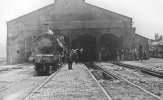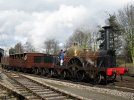mw0njm.
A Brummie Dude
yer they sure was a tough bunchReal Men
yer they sure was a tough bunchReal Men
There's alot of good railway videos on You Tube iv just download a load for later veiwingThe Railwaymen (1946)
Yes iv got most of them it was hard graft iin them dayssure is i like watching the old BRITISH TRANSPORT FILMS
just good interesting entertainment
Nope
When you have finished searching on Birmingham, try "Saltley" - loads of wonderful photos in high resolution of the Saltley ShedTry having a look on the Midland Railway Study Centre website:- www.midlandrailwaystudycentre.org.uk
A basic search on Birmingham brings back over 1600 entries - all kinds of things - photos, letters, documents etc. Hours of fun!!!
And then try searching on this:-When you have finished searching on Birmingham, try "Saltley" - loads of wonderful photos in high resolution of the Saltley Shed


I always like the broad gage.........still think it's better but I didn't get to voteView attachment 199356
Photograph showing the Birmingham end of Bordesley engine shed with a locomotive standing over one of the ash pits. This shed was built in 1855 for the broad gauge locomotives that operated on the Birmingham & Oxford Junction Railway, but was modified when the Great Western Railway converted its northern routes to standard gauge. This is why the door apertures appear so much larger than necessary. The shed was a brick structure with large round topped windows and had a gable style roof with central clearstory to assist ventilation. The shed was 327 feet long and 58 feet wide, but an office and store on the right hand side at this end meant the width at this point was 65 feet. The four roads ran the length of the building with 316 feet long pits under each. All four roads were accessible from both ends of the building. The attached store was sixty foot long by seven feet wide, while several separate adjacent buildings included; another store (36 feet by 20 feet), offices (48 feet by 15 feet), smithy (50 feet by 23.5 feet) and a sand furnace (16 feet by 23.5). There was also a Boiler House (20 feet, 7 inches by 18 feet, 4 inches and Pump House (16 feet by 16 feet). In 1902 a new 45 foot diameter turntable was installed together with a large covered coaling stage, these replaced existing facilities. The Bordesley engine shed closed in June 1908 following the construction of the new facilities at Tyseley.
Robert Ferris
There's a short length at Didcot (Great Western Society Museum) but the one working locomotive, 'Fire Fly', is out of service awaiting a boiler overhaul. It would be nice (but horrifically expensive) to build a Broad gauge heritage railway somewhere, where there could be full length trains and locos capable of pulling them between two stations a few miles distant.I always like the broad gage.........still think it's better but I didn't get to vote

It was probably due to the northern parts of Britain that the narrow gauge was adopted over the broad gauge - being a product of frugality and other things but I couldn't possibly comment.I always like the broad gage.........still think it's better but I didn't get to vote
Not quite frugality - more a case of "Is it necessary?" Speeds in excess of 60 MPH were not under consideration, and standard (narrow to the GWR) gauge had proved capable for the task in most other railway constructions, so GWR were literally put out on a limb.It was probably due to the northern parts of Britain that the narrow gauge was adopted over the broad gauge - being a product of frugality and other things but I couldn't possibly comment.
Very nice and informative article!View attachment 199368Brunel's Broad Gauge Railway | Didcot Railway Centre
Living Museum Of The Great Western Railwaydidcotrailwaycentre.org.uk
Yes my playgrounds only got shouted at onceanyone remember the railway coaches being stored in the sidings down aston church rd. we used to sit in them and have a crafty fag untill the security found us an evicted us
When it’s GWR & steam, it’s all good!
GWRWhen it’s GWR & steam, it’s all good!
